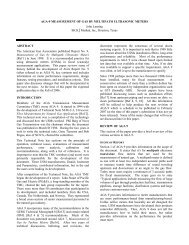Effects and Control of Pulsation in Gas Measurement
Effects and Control of Pulsation in Gas Measurement
Effects and Control of Pulsation in Gas Measurement
Create successful ePaper yourself
Turn your PDF publications into a flip-book with our unique Google optimized e-Paper software.
depend<strong>in</strong>g on daily volume, <strong>and</strong> could be as low<br />
as 0.20 %SRE.<br />
The simplest method <strong>of</strong> reduc<strong>in</strong>g pulsation<br />
<strong>in</strong>duced SRE is to raise the ∆P by chang<strong>in</strong>g the<br />
orifice plate. Unfortunately, this may also limit<br />
the operat<strong>in</strong>g range <strong>of</strong> the measurement<br />
system.<br />
In some cases, the pip<strong>in</strong>g system can be<br />
modified or the pulsation source moved to<br />
reduce SRE. This can be time consum<strong>in</strong>g <strong>and</strong><br />
costly.<br />
Another popular "cure' for high SRE is to <strong>in</strong>stall<br />
a device, such as a restrict<strong>in</strong>g orifice, between<br />
the pulsation source <strong>and</strong> the measur<strong>in</strong>g station.<br />
The negative effects <strong>of</strong> restrict<strong>in</strong>g devices are<br />
<strong>in</strong>creased cost <strong>of</strong> compression <strong>and</strong> a limited<br />
flow range.<br />
%SRE can also be reduced by <strong>in</strong>stall<strong>in</strong>g an<br />
acoustic filter to remove most <strong>of</strong> the pulsation.<br />
Though more costly than a restrict<strong>in</strong>g device, a<br />
properly designed acoustic filter will operate<br />
over a much wider flow range with a lower<br />
pressure drop.<br />
If %SRE is above your contract limits, it is a<br />
good idea to contact an expert such as<br />
SouthWest Research <strong>in</strong> San Antonio, Texas for<br />
more extensive test<strong>in</strong>g to determ<strong>in</strong>e a solution.<br />
Gauge L<strong>in</strong>e Errors<br />
Gauge L<strong>in</strong>e Error (GLE) exists when the ∆P at<br />
the taps does not equal the ∆P at the end <strong>of</strong><br />
the gauge l<strong>in</strong>es. GLE may be caused by<br />
pulsation or flow phenomena.<br />
The gauge l<strong>in</strong>e starts at the orifice taps <strong>and</strong><br />
ends at the transmitter, flow computer, or<br />
chart recorder connections. It <strong>in</strong>cludes any<br />
pipe fitt<strong>in</strong>gs, valves, valve manifolds, tube<br />
fitt<strong>in</strong>gs, <strong>in</strong>strument tub<strong>in</strong>g, <strong>and</strong> condensate<br />
chambers or bottles that may be <strong>in</strong>stalled<br />
between the orifice taps <strong>and</strong> the measurement<br />
device.<br />
Based upon research conducted by SWRI, it<br />
has been determ<strong>in</strong>ed that gauge l<strong>in</strong>e error has<br />
two components:<br />
1) Gage L<strong>in</strong>e Distortion: def<strong>in</strong>ed as the<br />
amplification (<strong>in</strong>crease) or attenuation<br />
3<br />
(decrease) <strong>of</strong> the pulsation amplitude <strong>in</strong> the<br />
gauge l<strong>in</strong>es. Gauge l<strong>in</strong>e distortion is similar to<br />
the noise created when play<strong>in</strong>g a flute or<br />
blow<strong>in</strong>g across the top <strong>of</strong> an open bottle.<br />
2) Gauge L<strong>in</strong>e Shift: def<strong>in</strong>ed as the actual shift<strong>in</strong>g<br />
<strong>of</strong> the average pressure along the length <strong>of</strong> the<br />
gauge l<strong>in</strong>e. Gage l<strong>in</strong>e shift may be created by<br />
pulsation rectification effects, which occur<br />
when the ∆P signal is transmitted through<br />
chang<strong>in</strong>g <strong>in</strong>side diameters <strong>of</strong> gauge l<strong>in</strong>e<br />
created by multiple <strong>in</strong>strument tub<strong>in</strong>g sizes,<br />
bottles or condensate chambers, shut-<strong>of</strong>f<br />
valves with a smaller ID than the <strong>in</strong>strument<br />
tub<strong>in</strong>g, or male-to-female NPT connections.<br />
Other causes <strong>of</strong> gauge l<strong>in</strong>e shift <strong>in</strong>clude gas<br />
oscillation at the mouth <strong>of</strong> the gauge l<strong>in</strong>e, <strong>and</strong><br />
density changes caused by pressure <strong>and</strong><br />
temperature fluctuations <strong>in</strong> the gauge l<strong>in</strong>e.<br />
Measur<strong>in</strong>g Gauge L<strong>in</strong>e Errors<br />
In 1990, a GLE <strong>in</strong>dicator was developed by PGI<br />
International. In 1996, improvements to the earlier<br />
model <strong>in</strong>cluded the capability to perform both %SRE<br />
<strong>and</strong> GLE tests. (shown <strong>in</strong> Figure 2). The Indicator<br />
was developed by PGI International to <strong>in</strong>dicate <strong>and</strong><br />
quantify both gauge l<strong>in</strong>e error <strong>and</strong> square root error.<br />
Used extensively over the past five years, it has<br />
proven to be quite useful <strong>in</strong> the study <strong>of</strong> gauge l<strong>in</strong>e<br />
<strong>and</strong> square root error.<br />
Figure 2<br />
The GLE <strong>in</strong>dicator is designed to compare the, ∆P at<br />
the orifice taps to the ∆P at the end <strong>of</strong> the gauge<br />
l<strong>in</strong>es. If the two signals are not the same, the<br />
difference will be due to gauge l<strong>in</strong>e error.




